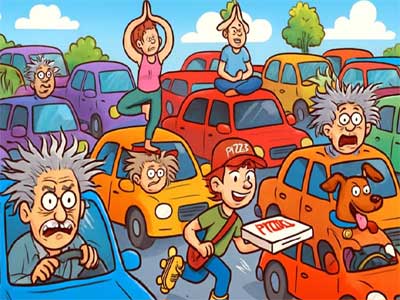IT geek Suresh Bhai had to get to a restaurant in Delhi's Daryaganj area from Vasant Vihar, carrying a gift for his fiancée’s anniversary party. Filled with enthusiasm, he entered the restaurant only to find the celebration over. Suresh blamed the traffic jam, but Sheela wouldn't hear any excuses and left with her old friend Abhinav. Truly, traffic jams have given people all kinds of bittersweet experiences.
The procession of vehicles on urban roads and the relentless blaring of horns feels like a disrupted orchestra. In this ‘everyday jam-of-life’, where cars crawl at a snail’s pace, sometimes fate turns a corner so unexpected that people start blessing the jam rather than cursing it.
Read in Hindi: ट्रैफिक जाम में छुपे हैं हंसी-ठट्ठे और हुकूमत की नाकामियां
Take a tale from Bengaluru—a man was stuck for hours in a traffic jam, exchanged glances, hearts fluttered, and the matter reached marriage. They say, this time, the jam played cupid.
Another IT guy saw truckloads of office chairs stuck in the jam and made a meme: “Let’s have mobile meetings in traffic jams too”—adding, in a 70-hour workweek, these ‘jam hours’ should be counted as productive time. Elsewhere, a traveller sitting on Marathahalli Bridge received a safety check message from his phone, since his car hadn't moved for several minutes. He replied, “The risk is boredom to death, not danger.” His tweet went viral and brought laughter and relief to many. In Mumbai, the ‘bazaar of jams’ on the streets has made vada pav vendors thrive. An old delivery boy now serves vada pav to people stranded in traffic, building a mini-empire.
Nowadays, there’s a ‘Chauraha Jam Yatra’ tour package being sold jokingly, offering city tours to notorious choke points. The sarcasm led the government to be compelled to promise reforms. Meanwhile, a burst of rain in Gurgaon turned cars into boats and a minister into a Ganga bath posture, flooding social media with memes.
But behind this humour, the reality is much harsher—the mismanagement of the city’s local governments. The negligence of police and municipal bodies has made traffic an uncontrollable monster.
In metro cities, car drivers spend several days each year crawling on roads. Dysfunctional public transport and poor road conditions have made things harder. Sometimes people abandon their cars to walk home, rain or during peak-hour chaos. Municipalities and traffic police fail to coordinate with contractors, resulting in roads being dug up and left unrepaired for months.
The story of Taj City is no less painful. Near an apartment complex, a broken traffic signal led to a jam lasting more than two and a half hours. Traffic police are often accused of lacking data systems and decision-making abilities. Consequently, people are left to fend for themselves, and metro projects run without proper traffic management.
Illegal parking, encroachment on footpaths, and police silence have together turned the road into a death trap. There’s virtually no coordination between agencies.
A rainstorm in Gurgaon turns the city into a pond—after just an hour of rain, hundreds of cars start floating in water. The police are missing, and officials are absent. People question, “Where does our tax money go?”
The problem isn't just with the traffic police, but the entire urban governance. Cities are spreading rapidly, but there is no planning. As a result, traffic police are made scapegoats, while the real culprits are the municipal bodies and urban planners. Add to this corruption, where fines are collected but nobody pays attention to traffic jams.
Solutions do exist—better traffic signals, new junction designs, robust public transport—but as the saying goes, “The illness grew with every dose of the cure.” Bureaucratic sluggishness and lack of accountability keep things just the same.
City design, traffic light synchronisation, shortage of public transport, lack of coordination among government departments—these are the roots of the problem. Even Bengaluru’s Deputy CM admits that his children and High Court judges are troubled by jams—sometimes it takes 6-7 hours to cover a 10-15 kilometre stretch. Roads are dug up, left unrepaired for months; metros expand gradually, but there is no traffic data. Illegal parking, footpath encroachments, and conflicts among agencies make matters worse.
Amidst all this, memes, smiles, and romance have given traffic jams a new psychology—where anger turns to relief, and ordinary citizens laugh through the failures of governance to pass their time. A city without jams is still a dream, while the reality is an ordinary citizen stuck in traffic.


















Related Items
India stuck in traffic; Cities halt, Horns holler, and time takes a nap
Invisible bacteria get a free ride in Delhi air
Yoga, India’s timeless gift to the world…